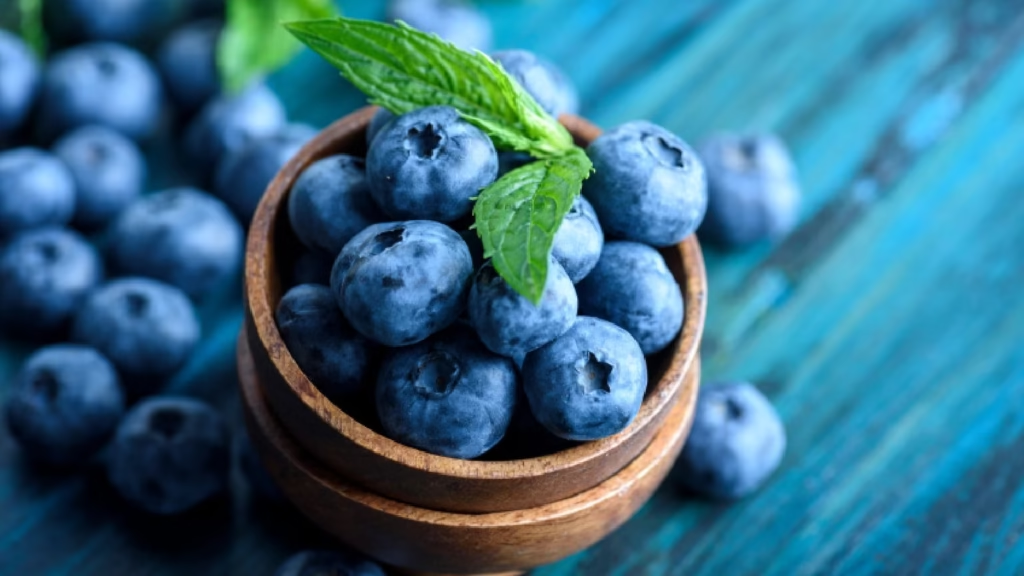The blueberry, a small, round fruit with a deep blue or purple hue, is one of the most popular berries worldwide. It is cherished not only for its sweet and mildly tart flavor but also for its impressive health benefits, particularly its antioxidant content. Blueberries are often referred to as a “superfood” due to their high levels of vitamins, minerals, and powerful antioxidants, which contribute to overall health and well-being. Widely grown in temperate regions, blueberries are available fresh, frozen, or dried and are commonly used in a variety of culinary applications, including smoothies, desserts, salads, and baked goods. Their rich flavor and nutritional profile make them a favorite among fruit enthusiasts.

Origin and History:
Blueberries are native to North America, with indigenous people using the fruit for both food and medicinal purposes long before European settlers arrived. Early European settlers learned about blueberries from Native Americans, who used them in pies, jams, and syrups. Blueberries became a staple crop in North America and spread to Europe and other parts of the world through cultivation. The development of commercial blueberry farming began in the early 20th century, and today, the United States, Canada, and several European countries are major producers of blueberries. In addition to being enjoyed fresh, blueberries are also freeze-dried or processed into juices, jams, and other products.
Varieties:
There are several varieties of blueberries, each suited to different climates and culinary preferences. Common types include:
- Highbush Blueberries: These are the most commonly cultivated variety, known for their larger size and sweet flavor. They are typically grown on shrubs that reach about 4 to 6 feet tall.
- Lowbush Blueberries: Smaller and more flavorful, lowbush blueberries grow in wild or cultivated environments and are often used in jams and baked goods.
- Rabbiteye Blueberries: A variety native to the southeastern United States, known for being more heat-tolerant, and producing large fruit with a slightly tangy flavor.
- Wild Blueberries: Smaller and more intensely flavored than cultivated varieties, wild blueberries grow in the wild and are harvested for their unique taste and nutritional properties.
Nutritional Value (per 100g of raw blueberries):
- Calories: 57 kcal
- Carbohydrates: 14.5g
- Dietary Fiber: 2.4g
- Sugars: 9.7g
- Protein: 0.7g
- Fat: 0.3g
- Vitamin C: 9.7mg (about 11% of the daily recommended intake)
- Vitamin K: 19.3µg
- Potassium: 77mg
- Antioxidants: Blueberries are loaded with anthocyanins, flavonoids, and other polyphenols, which contribute to their health benefits.
Health Benefits:
- High in Antioxidants: Blueberries are renowned for their rich content of antioxidants, particularly anthocyanins, which help protect the body against oxidative stress, inflammation, and cellular damage. These compounds are linked to a lower risk of chronic diseases, including heart disease and cancer.
- Improves Heart Health: Consuming blueberries regularly may contribute to better cardiovascular health. They help reduce blood pressure, improve cholesterol levels, and support healthy blood vessels, thus lowering the risk of heart disease.
- Boosts Brain Function: Research suggests that the antioxidants in blueberries may help delay age-related decline in brain function, improving memory and cognitive performance. Blueberries are often linked to enhanced brain health and a lower risk of developing neurodegenerative diseases.
- Supports Digestion: Blueberries are an excellent source of dietary fiber, which promotes digestive health. Fiber aids in regular bowel movements, prevents constipation, and supports the growth of beneficial gut bacteria.
- Regulates Blood Sugar: The fiber and antioxidants in blueberries help to regulate blood sugar levels, making them a suitable fruit for individuals with or at risk of diabetes. They can improve insulin sensitivity and reduce the risk of type 2 diabetes.
- Anti-Inflammatory Properties: Blueberries possess anti-inflammatory properties, which can help reduce the risk of chronic inflammatory conditions such as arthritis, heart disease, and certain cancers.
Culinary Uses:
Blueberries are a versatile fruit, used in a wide range of sweet and savory dishes:
- Fresh Consumption: Blueberries are often eaten fresh, added to yogurt, or enjoyed as a snack.
- Baked Goods: Blueberries are commonly used in muffins, pancakes, cakes, pies, and tarts, where their sweetness and juiciness enhance the flavor and texture.
- Smoothies and Beverages: Blueberries are a popular ingredient in smoothies, juices, and shakes, where their vibrant color and tangy-sweet flavor are a perfect addition.
- Salads and Sauces: Blueberries can be added to salads, paired with greens, nuts, and cheeses, or used to make fruit-based sauces and dressings.
- Frozen or Dried: Frozen blueberries are ideal for smoothies, baking, and snacking. Dried blueberries can be added to cereals, granola bars, or used as a topping for oatmeal.
Storage:
Blueberries should be stored in a cool, dry place and can be refrigerated for up to one week. To preserve their freshness for a longer period, they can be frozen. Simply spread them out on a baking sheet to freeze individually before transferring them to an airtight container. Freezing maintains their nutritional value, and frozen blueberries can be used directly in smoothies, baking, or cooking without thawing.
Fun Facts:
- Blueberries were once used by Native Americans to make dyes, medicine, and food.
- They are one of the few fruits that are native to North America.
- The antioxidants found in blueberries, especially anthocyanins, are what give them their characteristic color and health benefits.
- Wild blueberries have been found to have a higher antioxidant content than cultivated varieties.
